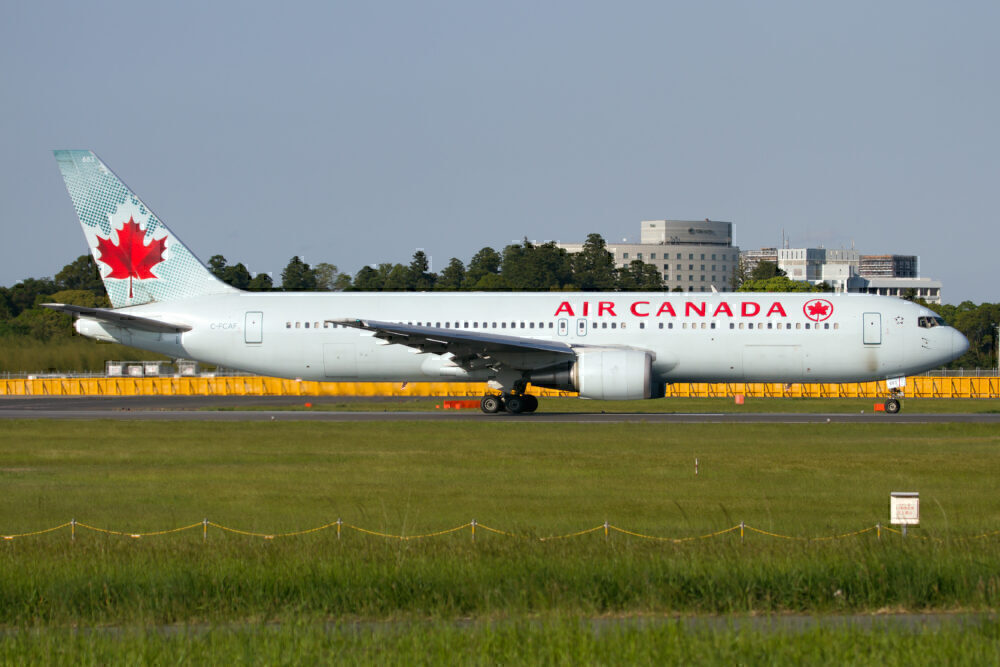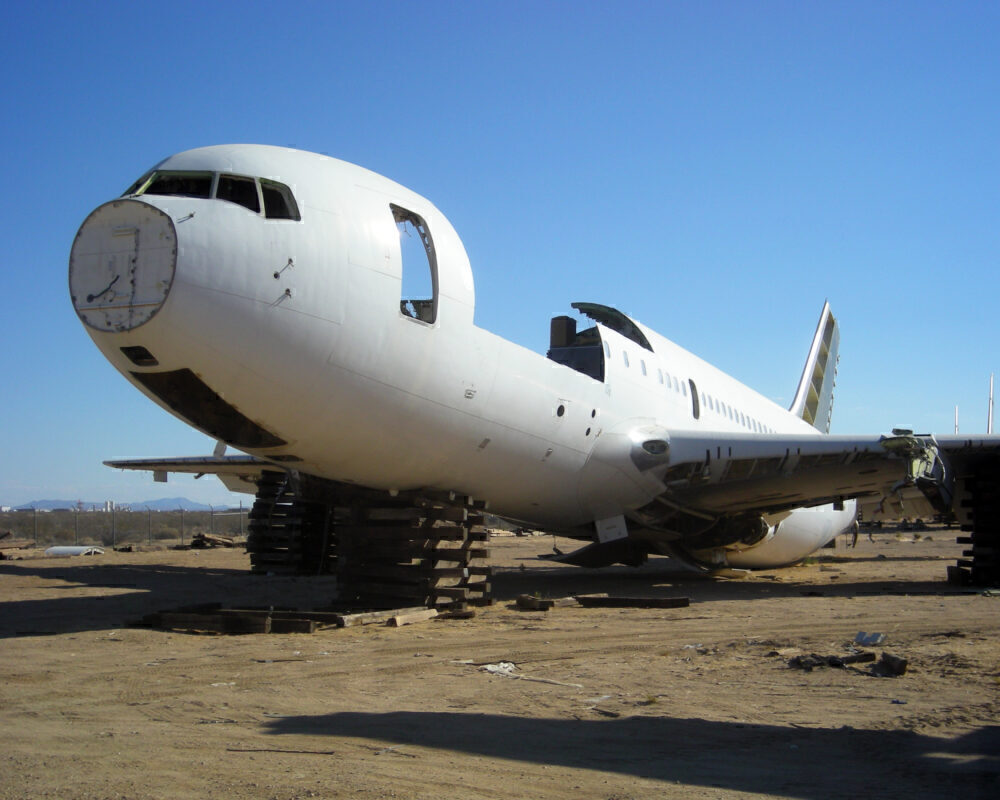It has been almost 38 years since the legendary event of the Gimli Glider. Due to a combination of technical issues and human error, an Air Canada Boeing 767 ran out of fuel at 41,000 feet. The pilots managed to glide the plane to a decommissioned airfield turned drag racing track. Miraculously, they landed without any severe injuries to passengers or crew. Even the aircraft itself went on to serve another 25 years with the airline.

Double alarms at 41,000 feet
On July 23rd, 1983, Air Canada Flight 143 took off from Montreal, Québec, and headed towards Edmonton, Alberta by way of Ottawa, Ontario. The flight was operated by a five-month-old Boeing 767-200 with registration C-GAUN. On board were 61 passengers and eight crew.
Shortly after 20:00, while the aircraft was cruising at 41,000 feet over Red Lake, Ontario, the cockpit crew received a warning of low fuel pressure in the left fuel pump.
The pilots first assumed the fuel pump had failed and switched off the alarm, as the Flight Management Computer (FMC) said there should be plenty of fuel. However, within moments, the right fuel pump alarm also sounded. The crew then decided to divert the aircraft to Winnipeg, 120 miles away.
As they commenced the descent, the left engine failed in a matter of minutes. No sooner had plans for a one-engine landing been made than a loud bang could be heard, and the cockpit alarm began blaring with ‘all engines out’. The plane lost all power.

Instruments gone
As if flying with no engines was not bad enough, the Boeing 767 was one of the first jets with an electronic flight instrument system powered by its engines. This meant that when the engines stopped working, all the instruments went dark.
Thankfully, the ram air turbine (RAT) was enough to power emergency flight instruments sufficient to land the aircraft. It also provided some hydraulic support for the crew to be able to maneuver the plane, which was not possible by muscular strength alone.
However, this did not include a vertical speed indicator that could have provided an idea of how far the plane could glide. Gimli, an old Air Force Base, was 20 miles closer to the aircraft’s location than Winnipeg.
Experienced glider pilot in the cockpit
The Captain was Robin ‘Bob’ Pearson, 48 years old, with 15,000 hours of flying time. With him in the cockpit was First Officer Maurice Quintal, aged 36, with 7,000 hours of flying time. By a stroke of luck, Captain Pearson was also an established glider pilot, and First Officer Quintal had trained at Gimli while serving in the army.

Crabbed their way to the runway
Even though the decommissioned base had no emergency services, it was deemed to be the safer option. However, neither of the pilots was aware the base had been turned into a drag racing track – with a major race scheduled for that very day.
The two heavy landing gears were dropped and locked into place using gravity, but the lighter nose gear only extended part-way down. Simultaneously, the crew realized that they were coming in too quickly and too high towards the ‘runway’. They then ‘crabbed’ the 767, angling it sideways like when landing in heavy crosswinds, causing more drag.
The nose gear gave out immediately as the plane touched down. Everyone on board survived. However, ten people did suffer lesser injuries during the evacuation. Investigators later found there were only 64 liters of fuel left in the tanks – but no leaks.
So how could this have happened? A combination of technical issues, organizational challenges, human error – and the metric system. First of all, there were problems with the plane’s Fuel Quantity Indication System (FQIS). The Boeing 767-200 had a dual processing channel, which meant that the other could operate on its own if one failed. However, that required the quantity to be cross-checked on the ground by a good old floatstick measurement.
Crossed wires
Following a flight the day before the incident, an engineer in Edmonton ran a service check on C-GAUN’s FQIS, according to a bulletin issued by Boeing. The system failed, which made the fuel gauges go blank as a result. Drawing on experience from a similar incident with the same aircraft a month prior, the engineer, in lieu of spare parts, fixed the problem by disabling the second channel and tagging the circuit breaker.
He informed the pilot flying out of Edmonton the next day that the fuel would need to be measured with a floatstick. However, there was a misunderstanding, and the information made it to Montreal and the change of crews in a highly muddled state.

System back on, tag remains
To complicate matters more, while the plane was on the ground in Montreal, a technician came into the cockpit and reengaged the second channel of the FQIS. Meanwhile, he was distracted by the fuel tank outside and never removed the tag from the circuit breaker. This causes the fuel gauges to remain completely blank.
That was not all that conspired to cause the Gimli Glider incident. Anyone who works internationally has sometimes come across the vexation of converting between imperial and metric measurements. Although, very rarely has it meant endangering close to one hundred lives.

Measurement transition
The plane had just been delivered to Air Canada from Boeing’s Everett facilities four months earlier. Meanwhile, the type itself had only been introduced into service ten months prior, and C-GAUN was the 47th specimen to roll out from the final assembly line.
It was the first aircraft in the Air Canada fleet to use kilometers on the fuel gauges, and the measurements needed to be entered in kg/L. However, the fueler who checked the floatstick reported the density in pounds/L as this was still the procedure for other Air Canada aircraft.
The cockpit crew then entered the value into the FMC without recalculating it for metric values. So instead of tanking the 20,088 liters of fuel required for the return flight to Edmonton, the plane left with just under 5,000 liters – about half of what was needed to reach their destination. The Captain repeated the same conversion issues after another floatstick test during a stopover in Ottawa.

Suspended and awarded
Following the incident, Captain Pearson was demoted for six months, and First Officer Quintal suspended for two weeks, along with three maintenance workers. However, two years later, the pilots were awarded the first-ever Fédération Aéronautique Internationale Diploma for Outstanding Airmanship.
C-GAUN was repaired in two days, and flew out to Winnipeg for full reparations. It returned to service with the airline and kept operating until 2008 when it was withdrawn from service and subsequently stored and partially scrapped at Mojave Spaceport.
[ad_2]
Source link


